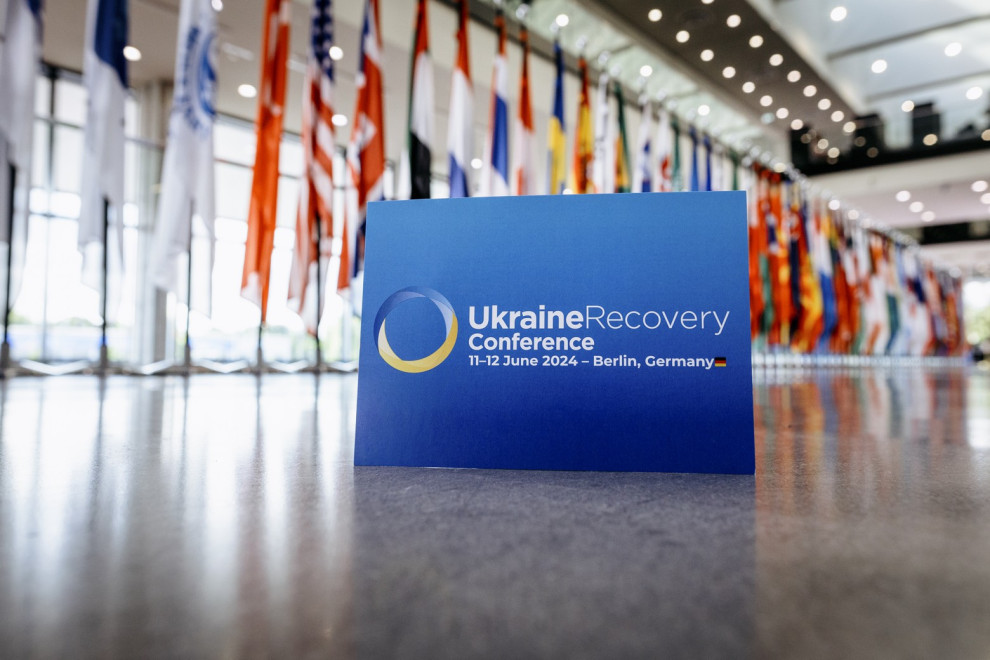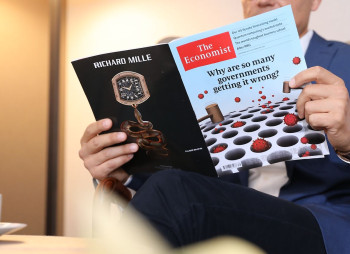Ukraine’s economy grew by 5.3 percent in 2023, according to recent official estimates, much in line with the forecast by the German Economic Team (GET) and the Institute for Economic Research and Policy Consulting (IER). For 2024, we estimate a further increase of 4 percent. However, Ukraine’s economy remains far from its pre-war level, after a GDP decline of 29 percent in 2022.
While improved private demand is the key driver of the current growth trajectory, which is further supported by positive development of export logistics via the Black Sea, Russia’s recent attacks on energy infrastructure, which caused cross-country electricity blackouts, clearly limit the growth perspective.
A Financing Challenge
Before the full-scale war, Ukraine’s economy was dominated by private sector business activities, accounting for roughly four fifths of gross value added (GVA) and three quarters of employment. However, these activities were primarily driven by domestic companies (approximately 88 percent), rather than by foreign ones (approximately 12 percent). Similarly, private sector investments remain key for both a stable economy under war conditions and sustainable long-term reconstruction in line with the so-called build back better principles.
Estimates by the World Bank, the European Union, the Ukrainian government, and the United Nations suggest a total of $486 billion in reconstruction costs (as of December 2023). These institutions highlight the fact that the private sector should play a critical role in overcoming this huge financing challenge. The public sector cannot and should not be the only contributor.
There is a vast amount of economic literature demonstrating that foreign direct investment (FDI) drives economic productivity gains, thereby lifting the growth trajectory and avoiding public sector crowding-out effects. This is why economists emphasize the importance of FDI as a “cornerstone” for modernizing and rebuilding Ukraine’s economy, as Torbjörn Becker and others have put it in “A Blueprint for the Reconstruction of Ukraine,” published by the Centre for Economic Policy Research in 2022. A successful FDI strategy for Ukraine rests on three important factors, which we will outline in the following paragraphs: on reliable sustainable financial public support; on de-risking and security against war risks; and on investment climate reforms and EU accession.
Reliable Public Support
First, sustaining economic and financial support from its partners is crucial for Ukraine’s resilience during the war. The financing of the budget is the ultimate condition for paying social assistance to people affected by the war; wages or saleries to soldiers, teachers, and other state employees; as well as for providing economic assistance to enterprises. This is no easy task. The International Monetary Fund (IMF) estimates a cumulative budget deficit of $81 billion between now and 2027 that will not be financed from domestic resources. Despite efforts to raise taxes, Ukraine is reliant on public aid from its foreign partners.
The EU’s recently adopted Ukraine Facility serves as a key anchor. Its Pillar I allocates approximately $41 billion (€38 billion) to Ukraine’s budget and is thus the main financing source for this time period. In addition, there is the assistance from international financial institutions (IFIs) such as the IMF and bilateral partners including Canada, Norway, Japan, and others. While all these efforts contribute to covering Ukraine’s estimated budget deficit needs, they still leave a gap of around $21 billion. Therefore, the US support package approved in April by the US Congress, which provides an additional $8 billion, is key to closing this gap.
Apart from the necessary financial support to keep Ukraine’s state functioning, further support is needed to strengthen economic resilience. For example, the re-establishment of the Black Sea export corridor is a success story that is contributing to Ukraine’s economic resilience without additional direct public aid. Further steps could include considering partial access to the European single market as well as alleviating existing border blockades that are currently causing economic disruptions.
In all these support steps, the EU is and will be playing the main role as Ukraine moves along its path toward full membership. Both kinds of support—for the budget and for export development—sustain the accumulation of international reserves of Ukraine. Its accumulation allows the National Bank of Ukraine to liberalize capital controls that have been in place since the introduction of martial law in 2022. Among other things, they restrict foreign businesses from transferring profits from Ukraine abroad—a direct challenge for new investment. Therefore, continued public support is a necessary condition for further liberalization steps in this regard.
De-risking and Investment Security
Second, private investments during the war and in its aftermath require both funding support and insurance guarantees. Banks have to set high risk weights for financing investment in Ukraine due to the low country rating. Unsurprisingly, interest rates are extremely high, and some businesses have lost collateral. Therefore, market-based financing is currently almost impossible. Again, the EU’s Ukraine Facility provides a key tool against this. The Pillar II investment framework intends to de-risk investment by providing approximately €8 billion to European IFIs for implementing financial guarantee schemes for private companies investing in Ukraine.
Another aspect is related to the insurance of investments. Direct damage to infrastructure and businesses was recorded at $155 billion in January 2024, according to an estimate by the Kyiv School of Economics. Therefore, the insurance of private investments against war damage is critical for new investment project planning during the war but also in the post-war period. Investment guarantees, such as those provided by the German government, offer this kind of protection and help to mobilize private investment from German companies. However, despite a record of 22 approved applications in 2023, the total volume of €55 million is still relatively modest.
Moreover, IFIs such as the European Bank for Reconstruction and Development (EBRD), the Multilateral Investment Guarantee Agency (MIGA, which is part of the World Bank Group) and others are actively working on similar schemes. However, a shift toward domestic investment guarantee schemes (obviously backed by Western financial support) could be a game-changer for domestic investors that make up the majority currently. In this context, it is important to highlight the strong link between security arrangements (e.g. bilateral or multilateral arrangements between Ukraine and partner countries), risk perceptions by investors, and their actual investments. The stronger these arrangements and commitments, the more secure investors will feel about their engagement in Ukraine, and the higher the resulting investments.
Investment Climate Reforms
Last but not the least, addressing longstanding rule of law issues is paramount for improving Ukraine’s business and investment climate. Judicial reform and alignment with the EU’s norms and regulations are integral to attracting more FDI and progressing toward EU accession. Here as well, Pillar III of the EU’s Ukraine Facility is key to providing technical assistance and incorporating the EU’s Instrument for Pre-Accession.
Despite obvious challenges due to the war, reforming the investment climate must continue. A recent joint study by the German-Ukrainian Chamber of Industry and Commerce (AHK Ukraine) and GET has outlined 30 concrete policy proposals in this regard. These proposals, based on input from AHK member companies, include horizontal and vertical market reforms in different sectors of the economy. Finally, as experience from previous EU enlargement rounds in 2004 and 2007 shows, the perspective of eventual EU membership is clearly driving FDI well before actual accession.
Key Investment Sectors
The key reference for all three pillars of the Ukraine Facility is the Ukraine Plan. This reform plan, developed by Ukrainian authorities and approved by the EU, sets out reform areas and identifies four key sectors—agriculture, energy, transport, and critical raw materials. Reforms and investment in these sectors are of great importance, accelerating Ukraine’s growth trajectory, and providing synergies with the cross-cutting objectives of green transition and digital transformation.
The focus on energy and green transition is of particular importance. While Russia is constantly attacking critical energy infrastructure, Ukraine has to find a balance between quick short-term basic rebuilding to keep the economy afloat as well as cities livable on the one hand and rebuilding by having in mind long-term sustainability goals on the other hand. Strengthening the decentralization of the energy system is highlighted as a key goal in the Ukraine Plan, which can help navigate this trade-off and simultaneously contribute to energy security and resilience. For example, installing rooftop solar photovoltaic panels combined with batteries can be economically efficient as decentralized systems for critical infrastructure facilities, such as schools.
Overall, Ukraine sees the reform plan as a cornerstone for investment in its economic recovery and economic convergence with peer countries, such as Poland, that are already EU member states. In addition, the defense sector is also an important area for investments. The inclusion of a number of representatives from German defense companies in a delegation that joined Vice Chancellor Robert Habeck’s visit to Kyiv in April demonstrates the interest of both the German and the Ukrainian side.
A Multifaceted Approach
Ukraine’s current journey from continued economic resilience toward recovery and reconstruction amidst an ongoing war requires a multifaceted approach, encompassing financial and economic support, investment climate reforms, and security and de-risking arrangements for private investments.
By tackling these factors and fostering collaboration between domestic and international stakeholders, Ukraine can navigate the challenges of war and emerge stronger, laying the groundwork for sustained economic growth and stability. Prioritizing these support measures is imperative for the duration of the war. Strengthening economic resilience is a necessary precondition for Ukraine’s survival amidst the ongoing challenges the war brings. Fiscal support, coupled with measures to enhance economic capacities, is essential.
While efforts to improve the investment climate and ensure investment security must continue, significant private capital inflows are likely to materialize only once the war subsides. A gradual transition from public to private funding sources will then ensue, marking a pivotal phase in Ukraine’s economic recovery. All in all, both the emphasis on continued immediate support for survival during the war and laying the conceptional ground for a sustainable “build back better” reconstruction should be the main priorities for this year’s Ukraine Recovery Conference.
The role of the EU in these processes cannot be overstated. Beyond the continued military, financial, economic, and humanitarian support, the EU accession process will have a potentially huge impact on private sector investments via two main channels: reforms in the area of rule of law―a traditional weak spot in Ukraine’s institutional framework―as well as obtaining full access to the opportunities offered by the single market of more than 450 million consumers.
This article is an extract from IP SPECIAL "Rebuilding Ukraine," published to coincide with the Ukraine Recovery Conference 2024 which takes places in Berlin on June 11-12.
Robert Kirchner is authorized representative and deputy team leader of the German Economic Team (GET) at Berlin Economics.
Garry Poluschkin is consultant and project manager Ukraine of the GET at Berlin Economics.






